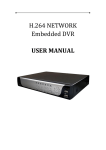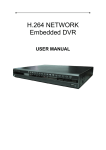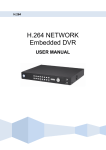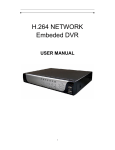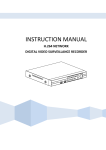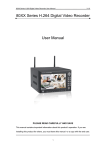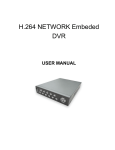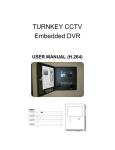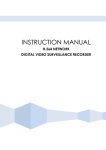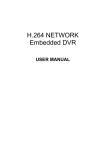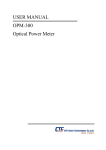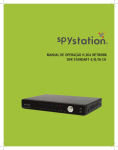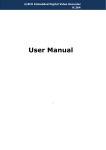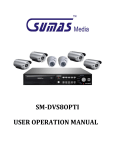Download SM-DV7F10 USER OPERATION MANUAL
Transcript
SMDV7F10 USER OPERATION MANUAL CONTENT INTRODUCTION ...........................................................................1 -PRECAUTIONS / FEATURES SPECIFICATIONS .........................................................................2 REMOTE CONTROL OPERATION ....................................................3 MOUSE OPERATION......................................................................4 DVR INSTALLATION ………………………………………………………..... 5-6 -FRONT PANEL CONTROLS 5 -REAR PANEL 6 SYSTEM OPERATION ……………………………………………………………..7 -STARTING THE SYSTEM/STANDBY MODE/SYSTEM LOGIN/MAIN MENU BASIC OPERATION ……………………………………….………………… 8-10 -USING THE SUB MENU/PLAYBACK/ON SCREEN PLAYBACK CONTROLS 8 -SEARCH 9 -FILE LIST/BACK-UP 10 RECORD MODE ……………………………………………………………….….. 11 HDD MANAGEMENT ……………………………………………………….….… 12 BASIC SETUP ………………………………………………………………….13-14 - DATE/TIME 13 - VIDEO/AUDIO 13 - PASSWORD 14 ADVANCED SETUP ………………………………………………………….. 15-19 -ALARM 15 -SYSTEM INFO/MOTION DETECT/MOBILE 16 -MAINTAIN 17 -NETWORK 18 -MANUAL DNS/DDNS 19 REMOTE SURVEILLANCE …………………………………………………. 20-25 -FEATURE / RESTRICTION CONDITION / USING REMOTE SURVEILLANCE 20 - REMOTE SURVEILLANCE SCREEN / USING REMOTE ACCESS OVER THE INTERNET 21 - LIVE VIEWING / RECORDING / SUB-MENU / SCREEN CAPTURE 22 - PLAYBACK / SEARCH 23 - REMOTE BACKUP / REMOTE SETUP / RECORD / ALARM / NETWORK - SETTINGS / MAINTENANCE / HOST INFO 24 25 FAQ ……………………………………………………………………………… 26-27 PACKING LIST ………………………………………………………………………………….….… 28 TROUBLE SHOOTING ………………………………………………..……..…. 29 REGISTRATION...………………………………………………………………… 30 INTRODUCTION This is a 4 channel digital video/audio (see below) recorder. It does local recording, playback and supports triple code remote network surveillance, which allows you to use remote view feature from internet when you are away. RESTRICTION Audio recording is illegal in some states, such as California. So please check with your local law enforcement to be sure it’s allowed in your area. PRECAUTIONS For your safety, while using the DVR and to prolong device life, please pay attention to the following details: o o o o o o o When installing device, please comply with all the electric product safety criteria. Power and ground: Do not touch the power and DVR with a wet hand Do not drop liquid on DVR Do not put any object on DVR Please use soft dry cloth to clean DVR; do not use harmful chemicals. Please unplug power line from power source if the Device is not intended to be used for a long period of time. FEATURES 7” LCD Display with 4 Day/Night CCD cameras H.264 compression Two USB interface, USB2.0 for data backup, USB1.1 for mouse operation. 500GB 3.5” SATA HDD Built-in. Special file system for security. 16 bit color translucent user-friendly GUI, with notes for selected menu items Optimized four channel simultaneously playback Audio recording input (four connectors, to select one only) 1 RCA Video Output, 1 Audio output Double level user management Support live view, parameter setting and copy playback video via network. Include triple code remote network surveillance Cell phone remote viewing, Alarm notification via E-mail Data backup Motion detection Supported Cell Phones: iPhone/Blackberry/Android/Windows mobile Phones. Note: Not all of the phone models are supported. (Check the list in the software CD) 1 SPECIFICATIONS Item Device Parameter Specification Language English GUI Graphic menu(OSD Menu) Video in 4ch composite video input 1.0Vp-p,impedance75Ω,BNC Video out 2ch composite video output 1.0Vp-p,impedance75Ω,BNC Video display 4ch:1/4channel switch Video standard NTSC,30f/s,CCIR525line,60scene Audio input 4ch audio input,impedance600Ω,RCA Audio output 1ch audio output,impedance600Ω,RCA Basic electricity output Linearity electricity Record style Audio video recorded simultaneously Audio compression ADPCM Picture compression H.264 Picture resolution CIF Streaming style ISO14496-10 Audio style ADPCM Video code rate(4CH) CIF: 384~768 Kbps(normal) Audio code rate 32KB/s Data storage 500GB 7200rpm SATA HDD storage Connector Network interface RJ45,10M/100M Alarm Alarm input 4 alarm input Alarm output 1 alarm output Serial interface Support 1 RS232 Serial interface Support 1 RS485 Network interface RJ45,10M/100M System Video Audio (with this feature’s legal issue concern, please read page one) Picture proceeding and store Connector Software upgrade Support USB firmware upgrade Voltage input AC:110~240V Voltage output DC: 19V/3A (Optional ) Power Consumption 6W without HDD Working temperature -10----50℃ Voltage input 19V DC 19V Voltage output for camera 12V(+/-0.2) 4channel :12V@2A Video impedance input 75Ω 75Ω each channel Video output 1Vp-p 1Vp-p CVBS signal Working temperature -10----50℃ Under normal conditions others 2 MOUSE OPERATION The mouse is the primary input device for navigating system menus. NOTE: Unless otherwise noted, all system functions described in this manual are achieved using the mouse. To use a mouse with the system: 1) Connect a USB mouse to the USB MOUSE port on front panel of the system. NOTE: The top USB port on the front panel is designed for data backup to a USB flash drive ONLY. Do not connect a USB flash drive to the bottom USB port on the rear panel. Figure 1 Connect a USB mouse to the bottom USB port on the front panel 2) Use the mouse buttons to perform the following: • Left-Button: Click to select a menu option. During live viewing in split-screen, double-click on a channel to view the selected channel in full-screen; double-click the channel again to return to split-screen view • Right-Button: Click to open the Sub-Menu • Scroll-Wheel: No function. 3 REMOTE CONTROL OPERATION REMOTE CONTROL The remote control is the secondary input device for navigating the system’s interface. The enter key on remote control has the same function as left click of the mouse. To use the remote control: 1. STANDBY: Press and hold to turn standby mode ON/OFF. 2. LOGIN/LOCK: If "Security" has been enabled in the Setup menu, press to open the user password login screen. 3. Number/Channel buttons: While in the menu, Press buttons 0~9 to enter values; during live viewing, Press to view channels in full-screen (1-4). 4. : Press to switch between full screen and quad-screen displays. 5. MENU: Opens the main menu. 6. EXIT: Close menu windows. 7. Navigation/OK: 8. • /CH+: Move cursor in menus up; Channel Up. • /FWD: Move cursor in menus right; during playback Fast forward playback speed (5X, 15X, 60X). • /REW: Move cursor in menus left; during playback, Rewind playback speed (5X, 15X, 60X) • /CH-: Move cursor in menus down; Channel down. • OK: Menu: press to confirm selections; during playback and preview: press to view system information. 9. +/ - : In menus, press to adjust values. 10. RECORD: Press to start manual recording. 11. STOP: Press to stop manual recording. 12. EXTRA: For the future use. TIP: When using the remote control to 13. Playback controls: enter password and camera titles, select • : Increase reverse playback speed 1X, 2X, 4X the field using the navigation buttons, • : Press to start playback Press ENTER, and then press • : Press to increase forward playback speed 1X, 2X, 4X the number buttons. • : Press to slow playback speed by 1/2, 1/4, 1/8 • : Press to freeze playback to one frame, then press again to advance frame-by-frame 4 DVR INSTALLATION GUIDELINE FRONT PANEL CONTROLS THE DEFINITION OF BUTTONS AND CONNECTORS ON REAR PANEL 1) Power: Press to power the system ON/OFF. 2) IR Sensor: IR receiver for the remote control. 3) LED Indicators: Shows status of HDD, recording, alarm, network, and power. 4) Channel/Numbers/Playback: Press buttons 1~4 (4-channel models) to view the selected channel in full-screen; press buttons 1~0 to input passwords and user IDs; during playback, press the following: 6] : Increase reverse playback speed 1X, 2X, 4X : Press to freeze playback to one frame, then press again to advance frame-by-frame 7] 8] : Press to start playback 9] : Press to slow playback speed by 1/2, 1/4, 1/8 0] : Press to increase forward playback speed 1X, 2X, 4X 5) MENU/EXIT: Press to open/close the main menu. 6) Navigation/OK: Press the Navigation buttons to perform the following: • OK: • : Press to move cursor up; • : Press to move cursor down; • : Press to move cursor left; • : Press to move cursor right; 7) LCD ON/OFF: Open or Close the screen 5 REAR PANEL Connectors on Rear Panel Item Physical connector Connector description 1 POWER Input DC 19V/3A 2 Video Output Two video output for connecting TV or monitor (BNC) +RCA 3 Audio Output For connecting analog video signal input (BNC) 4 Audio Input For connecting audio signal 5 Video Input For connecting the cameras 6 USB Connect a USB flash drive to the top port for data backup and firmware upgrades connect a USB mouse to the bottom port. 7 Network For connecting Ethernet 8 +12V Power supply 12V DC 100MA. For camera power feed and alarm. 9 Alarm Input 4 I/O alarm input 6 SYSTEM OPERATION STARTING THE SYSTEM To power the system ON/OFF: Connect the power cable to the DC 19V port on the rear panel. At startup, the system will perform a basic system check and runs an initial loading sequence. After a few moments, the system loads a live display view. Standby Mode The system can also be put into Standby Mode. Power will remain to the system but will not be recording. To start/stop Standby mode: 1) Press and hold the POWER button on the front panel or (STAND BY) on remote control until the prompt closes. The system enters standby mode. 2) Press and hold the POWER button on the front panel or (STAND BY) on remote control until the system beeps. The system will begin powering up. SYSTEM LOGIN To open the Main Menu: Right-click anywhere onscreen to open the Sub-Menu and select MAIN MENU (mouse only), or press the MENU/EXIT button on the remote control or front panel of the system. If the password is setup enter the correct password using the on-screen keyboard. MAIN MENU Main menu 1) SEARCH: Search for recorded video on the system. 2) RECORD: Configure recording parameters (quality, resolution, etc…) 3) HDD: Display hard drive status, override, and format options in the system. Note: You can also format a USB flash drive. 4) BASIC: Open the Basic Setup Menu, which lets you, set the date and time, Device IDs, Password and audio/video settings. 5) ADVANCE: Opens the Advanced Setup Menu, which lets you view: INFO/ALARM/MD/MOBILE/MAINTAIN/NETWORK SETTINGS 6) EXIT: Closes the Main Menu. 7) Displays information about the contents of the selected Main Menu icon. *Audio capable cameras (not included) are required for audio recording on the system. 7 BASIC OPERATION USING THE SUB-MENU Mouse Only When using the mouse, display the Sub-Menu to access several system options. To open the Sub-Menu: 1) Right-click anywhere onscreen. The Sub-Menu opens. 2) Select one of the following options: • MAIN MENU: Opens the main system menu • KEYLOCK: Locks buttons on the front panel • CHN SWITCH: Select type of split-screen display • VIDEO SEARCH: Opens the Search Menu to view recorded video • MUTE OFF: Turns mute option off. • MANUAL REC: Starts manual recording • STOP REC: Stops manual recording • STANDBY: shutdown 3) To close the Sub-Menu, click anywhere on the screen. PLAYBACK View recorded video on the system through the Search Menu. To begin playback: 1) Right-click anywhere onscreen and select VIDEO SEARCH, to display the Search Menu. NOTE: When you first open the Search Menu, it displays the current month and date. 2) Click PLAYBACK to playback the last minute of recorded video. Quad screen will show up and play. 3) Double click on the desired channel to play in full screen. 3) To select a specific date: By clicking on the desired number from the drop down list from left to right, to input the desired date on “Record File” section. 5) Click SEARCH. Recorded events on the system appear in red (alarm events—includes both alarm and motion events) and green (normal recording). 6) Click a date in the Month Grid to search for video files. 7) Click a time block in the Hour Grid to view the video. Playback begins. Onscreen Playback Controls To use the onscreen playback controls: 1) Click the VCR-like controls to play, pause, fast forward, rewind, and slow down playback. 2) Drag the slider to adjust the volume (audio capable camera required, not included). Select the box to mute the audio. 3) Move the mouse slightly to display the onscreen playback controls. You can also use the playback control buttons on the remote control or front panel of the system. 4) Click X to quit playback and return to the Search menu. 8 SEARCH Search and playback recorded video on your system. NOTE: When you first open the Search menu, it will display the current month and date. To perform a Quick Search: - Open the Search menu and click SEARCH. Recorded events on current month will show in red. To perform a Date & Time search: 1) Under DATE, click the field and enter the desired date using the Virtual Keyboard click when done and then click “SEARCH”. The system will search for data. 2) Under “RECORD STATE”, the system shows recorded events in a Month Grid and a Time Grid. The selected day of the month will be outlined in red. Green=normal recording; Red=alarm recording (includes both alarm and motion events). Record grid 3) Click a date in the month grid to view recorded video files for that selected date in the hour grid. Playback will begin. 4) During playback, use the onscreen controls or the playback buttons on the remote control or front panel to control playback. 9 FILE LIST Use the File List sub-menu to see a detailed list of all the recorded video on your system. To open the File List: 1) From the Search Menu, click SEARCH to search the system for recorded video. - Repeat steps 1-2 from Search on page 7 to select specific date. 2) Click FILE LIST at the bottom of the menu. The File List menu opens. File list menu To use the File List: 1) Under “CHN SWITCH”, select the desired channel to be viewed (1-4 or ALL) 2) Under “TYPE”, select NORMAL to view only normal recordings, ALARM, to view alarm recordings (includes alarm and motion detection), or ALL to view all video on the selected date. 3) Use the buttons on the side panel to navigate the file list: • FIRST: Jump to the first page of the list • PRE: Turn to the previous page • NEXT: Turn to the next page • LAST: Jump to the last page of the list • ALL: Selects all files (puts a check mark on the “BAK” box • OTHER: Clear all files • BACKUP: After selecting the desired file(s), click to begin copying the data to a USB flash drive (not included); 4) Click any file to begin playback. BACKUP Use the File List sub-menu to find recorded video on your system and copy it to a USB flash drive (not included). NOTE: The system is compatible with most major brands of USB flash drives, with capacities from 256 MB to 4 GB. To backup recorded data: 1) Connect a blank USB flash drive to the top USB port on the back of the unit. 2) Open the Search menu and select the desired date for recorded data on the system. 3) Click FILE LIST. 4) Select the files you want to backup and click the "BAK" box next to the file name (see picture below). Select multiple files if desired. Click ALL to select all files; click OTHER to deselect all files. NOTE: The size of each file is shown in the File List menu. Use this to help you find a USB flash drive with enough space to hold all the files you wish to backup. 5) Click BACKUP from the side-panel to immediately begin copying the files to the USB flash drive. NOTE: Backup progress appears in the status window. DO NOT remove the USB flash drive during backup. 1) When the space in backup device is less than recording file, the system will prompt “Space not enough”... 2) You can remove USB device directly when backup is finished. 10 RECORD MODE Configure record parameters, enable/disable audio. Note: To display a channel in full screen, double click on the desired channel (1-4); double click to go back to quad-screen view. To configure recording options: 1) CHANNEL: Select the desired channels (1-4) to be turned ON/OFF. 2) RESOLUTION: Select from Normal/High/Highest 3) QUALITY: Select from Normal/Fine/Best 4) AUDIO: Select Enable/Disable 5) POWER UP: The system will continuously record on startup (under Normal Recording) . 6) TIMER RECORD: Will record a set schedule 7) REC. SIZE: Select from 15MIN/30MIN/45MIN/60MIN 8) Click APPLY. Click CLOSE in the confirmation window. 9) Click EXIT in every menu until all windows are closed. Record Recording Schedule - Automatic Record mode To set the DVR in automatic record mode: 1) Select “Record” from the main menu. 2) Under “Channel” turn on all the desired channels you want to record. 3) Select the desired resolution. 4) Enable/disable audio (audio capable cameras ONLY) 5) Under “Rec. Mode” Select “Power Up” from the drop down menu. 6) Under “Rec. Size” select from 15/30/45/60mins. This determines how long the batch per recording will be. For example if the record size is set to 15min, the recorded data will be in intervals of 15minutes, for continuous recording but more convenience when reviewing. 7) Click on “Apply” and wait for confirmation and then click “Exit” until you reach live view. - Timer Record mode To set the DVR in Timer record mode: 1) Repeat steps 1-4 above (under Automatic Record Mode) 2) Under “Rec. Mode”: Select “Timer Record” 3) Click on Schedule, a new window will pop-up. 4) Under “Channel”: Select which channel you want to schedule, from 1-4 or all from the drop down menu. 5) On “Recording type” (see picture above): Click a box to select from Alarm/General/No Record 6) Click on the desired day and time on the recording grid to set the recording schedule each day. 7) If desired schedule will be the same everyday, repeat steps 1-6 above for “Sunday”, then on the copy section, select “Sun.” from the “From” and then select “ALL” from the “To”, then click “Copy”. This will copy the same schedule from Sunday to Saturday. 8) Click “Apply” and wait for confirmation and then click “Exit” until you reach live view. - Manual Record mode To set the DVR in Manual record mode: 1) Repeat steps 1-6 from “Time record mode” but leave the entire recording grid blank. 2) Click “Apply” and wait for confirmation and then click “Exit” until you reach live view. 3) To start manual recording: Right click anywhere on the screen and select “Manual Record” 4) To stop recording: Right click anywhere on the screen and select “Stop Record” 11 HDD MANAGEMENT Displays essential information about the system’s internal hard drive, and lets you format the internal HDD and external USB flash drive (not included). HDD management menu The HDD menu displays the following: • HDD STATUS: The system will display "OK" for normal operation • SIZE: The total size (in gigabytes) of the internal hard disk drive. • FREE SPACE: The free space (in gigabytes) remaining on the system’s internal HDD. • AVAILABLE TIME: The recording time (in hours) remaining on the HDD based on your current record settings • OVERWRITE: Select ENABLE or DISABLE. If Overwrite is enabled, the system will record over the oldest video data once the HDD is full. If Overwrite is disabled, the system will STOP recording once the HDD is full and the "FULL" LED on the front panel of the system will light up. Formatting the Hard Drive Formatting the hard drive can only be done on the unit. The hard drive cannot be formatted remotely! ATTENTION: Formatting the HDD will erase all video data. This step cannot be Undone. Also unit has warranty seal label not to be broken for warranty. Formatting the USB Flash Drive Use a USB flash drive to backup recorded video and upgrade the system’s firmware. You should always format the USB flash drive you intend to use with the system. NOTE: Not formatting the USB flash drive may result in improper functionality. 12 BASIC SETUP DATE/TIME It is highly recommended to immediately set the date and time when first setting up your system. To set the date and time: 1) Click DATE/TIME and configure the following options: • DATE: Enter the day, month, and year. • DATE FORMAT: Select DD/MM/YYYY, MM/DD/YYYY, or YYYY/MM/DD • TIME: Enter the time • TIME FORMAT: Use the drop-down menu and select 12HOURS or 24HOURS • DST: Use the drop-down menu to select ON/OFF to enable/disable Daylight Savings Time 2) Click MODIFY DATE AND TIME. Click CLOSE in the confirmation window. 3) Click APPLY. The new date and time are saved. Daylight Savings Time To set daylight savings time: 1) Under DST, select ON. DST options appear. 2) Under DST MODE select one of the following: • CUSTOM: Set customized start and end times for DST (go to step 4) • DEFAULT: The Default setting will apply DST from the second Sunday of March to the second Sunday in November (go to step 3) 3) If using the DEFAULT, click APPLY. 4) If setting a CUSTOM DST, use the drop-down menus to select a week and month for the start and end times. 5) Click APPLY. Click CLOSE in the confirmation window. 6) Click EXIT in each menu until all windows are closed. VIDEO/AUDIO Camera System: Select from NTSC or PAL (NTSC for US only) Loop Time: Single channel display rotation time. Input any time desired up to 999 seconds. Volume Setup: Select from 0-63 (This unit has no built-in speakers) Adjust Margin: Use to align screen (Top/Bottom/Left/Right) to fit the LCD. 13 PASSWORD When you first startup your system, you are technically logged in as the ADMIN under Device ID000000. The system employs two user authorities connected to a Device ID. The authorities are as follows: • ADMIN - Administrator: Has full control of the system, and can change both administrator and user passwords and enable/disable password checking • USER - Normal user: Only has access to live viewing, search, playback, and other limited authorities. NOTE: For security reasons, it is highly recommended to enable passwords on your system. If you enable passwords, you must select a 6-digit USER password and a 6-digit ADMIN password. If you ever forget the password you’ve inputted, use the override code below: PASSWORD Override code 020818 ATTENTION: By default, passwords are disabled on the system. You do not need a password to log in or access menus. You will not need a password to access your system using the browser-based remote software. Password You can change the Device ID and password of the ADMIN and the USER from the Password menu. To open the Password/security menu: 1)Right-click anywhere onscreen to open the Sub-Menu and select MAIN MENU. 2)Click BASIC. The Basic Setup Menu opens. 3)Click PASSWORD. The Password/Security menu opens. To change your Device ID and Password: 1)Click the field beside DEVICE ID and enter a 6-digit numerical Device ID using the Virtual Keyboard (mouse only). 2)Under PASSWORD, select ENABLE. 3) Click the field beside USER PASSWORD to enter a 6-digit numerical password using the Virtual Keyboard (mouse only). Re-enter the password in the corresponding field. 4) Click the field beside ADMIN PASSWORD to enter a 6-digit numerical password using the Virtual Keyboard (mouse only). Re-enter the password in the corresponding field. NOTE: The USER and ADMIN passwords MUST NOT be the same. 5)Click APPLY to save your changes. Click CLOSE in the confirmation window. 6)Click EXIT in each menu until all windows are closed. Use your new password to log in to the system and access system menus. NETWORK PW CLEAN: (PW = Password) Select and click APPLY this will disable the IE browser password 14 ADVANCE SETUP ALARM Alarm function and email notifications setup. Once setup, you will get email notifications with a screenshot of what triggered the alarm. ALARM SETUP EMAIL SETUP TAMPER ALARM SETUP Alarm Setup 1) From the main menu select “ADVANCE” 2) Then click on “ALARM” 3) Under “I/O ALARM”: Select the desired camera to be turned on from the drop down menu. Select “NO” Normal Open circuit, “NC” Normal Close circuit (“I” will show up on the screen), or “OFF”. Note: “NO” = High frequency above 2.2 MHz of your burglary alarm system. “NC” = Low frequency below 2.2 MHz of your burglary alarm system (standard operation). 4) HDD LOSS: Turn on to get email notification if the hard drive gets disconnected or stops working. 5) VIDEO LOSS: Turn on to get email notification if one or more of the camera looses video feed. 6) HDD SPACE: Turn to get email notification if the HDD runs out of space. (when “overwrite” is disabled) 7) Under “ALARM MANAGER”: “OUTPUT” select from 0/10/20/40/60 seconds to set the time in which the email notification will be sent. “BUZZER” select from 0/10/20/40/60 seconds to set how long the buzzer will go on for. “POST REC” select from 30s/1min/2min/5min to set how long the unit will record for, after the alarm is triggered. 8) Click “APPLY” and wait for confirmation then click “SURE” on the confirmation window. Email Notification Setup 1) Click on “EMAIL SETUP” the email setup screen will pop-up. 2) Under “EMAIL” select “ON” from the drop down menu. 3) “SSL” select “ON” if your email requires SLL. 4) “SMTP PORT” enter you emails SMTP port, if any, if you are not sure just leave blank. 5) “SEND EMAIL”: Enter the email address you want to send from. 6) “SEND PW”: Enter your emails password. 7) “RECV EMAIL”: Enter the email address where you want to receive the email notifications. 8) Click “APPLY” and wait for confirmation then click “SURE” on the confirmation window. Note: Please make sure that the camera is not located at a high movement area in/out of the building, to minimize the email notifications. Tamper Alarm Setup Intergrades to burglary alarm system for motion intrusion notification. 1) 2) 3) 4) Click on “TAMPER ALARM SETUP” the tamper alarm setup screen will pop-up. For each channel, select the desired channel to be turn on/off from the drop down menu. Under “SENSITIVITY”, select from “LOW/MIDDLE/HIGH”. Repeat for each channel. To cancel or stop using, click on “Default”, then click “APPLY” and wait for confirmation. This will turn all the channels OFF. Note: We require that you have a professional installer to install and setup these features, to avoid having your alarm system to go off prematurely. 15 SYSTEM INFO View system information, including the firmware version, MAC address, and serial number of the system. System Info MOTION DETECT (MD) Configure motion detection for each channel. Motion detect To configure motion detection: (Also how to save storage space on unwanted motion detection recording, by disabling a section of screen that has constant of motion ….such as flag) 1) Under STATUS, select ON to enable motion detection for the desired channel. 2) Under SENSITIVITY, select 1, 2, 3, or 4. The higher the number, the more sensitive the motion detection will be. (See top left graphic) 3)Under MD AREA, click SETUP. The red motion grid appears over the selected channel in full screen. 4) Click hold and drag the blocks in the grid to enable/disable motion detection area. Red=motion detection enabled; Clear=motion detection disabled. (See top right graphic ) 5)Right-click anywhere on the screen to return to the Motion Detection menu. - Repeat about steps for each channel. 6) Click APPLY. Then click CLOSE in the confirmation window. 7) Click EXIT in all menus until all windows are closed. MOBILE Mobile: To enable remote cell phone viewing. (Selected Cell phones ONLY) MOBILE NETWORK: Select from the drop down menu: 2.5G/2.75G/3G NETWORKS. MOBILE PORT: Input the open port value from your router. Note: To view DVR from a cell phone, you must have an open port configured from your router (see quick start guide) 16 MAINTAIN Use the Maintain menu to update system firmware and set an automatic system reset schedule. To enable auto-reset: 1) Under AUTO RESET, select ON. The Settings option appears. 2) Under SETTINGS, select EVERY DAY, EVERY WEEK, or EVERY MONTH. The date drop-down menu appears. 3) Select the date for auto-reset from the drop-down menu. 4) Enter the time for auto-reset using the Virtual Keyboard (mouse only). 5) Click APPLY. Click CLOSE in the confirmation window To restore factory settings: 1) Click DEFAULT SETTINGS. This will restore the system to the original factory settings. 2) Click OK to confirm. NOTE: Recorded video on the HDD will not be erased. To restart the machine (soft/partial-reset): 1) Click RESTART. 2) Click OK to confirm. The system will perform a soft/partial-reset and load to a live split-screen view. To upgrade firmware: (For future use) 1) Copy the firmware file to an empty USB flash drive. The firmware file should not be in a folder. 2) Connect the USB flash drive to the top USB port on the front panel of your system. 3) Open the System Menu (Main Menu>Advance>System). 4) Click “FIRMWARE UPDATE”. The system will scan the USB flash drive and begin updating the firmware. Do not remove the USB flash drive while the upgrade is taking place. 5) Click CLOSE in the confirmation window. In the system prompt, click OK. The system will restart. PARAMETER EXPORT: Copy the system settings of the device to an empty USB flash drive. PARAMETER IMPORT: Import system settings from another device. 17 NETWORK Use the Network Setup menu to configure your network and DNS settings. Please consult professional to help setup remote viewing! Network setup To configure network settings: Under TYPE: select DHCP, PPPoE, or STATIC. If DHCP, go to step 5. If PPPoE, go to step 2. If STATIC, go to step 3. NOTE: DHCP allows you to quickly connect to your network by obtaining an IP address from the router. After the initial setup, we recommend that you disable DHCP and set the IP address between 1~100. For example, if your IP address is 192.168.0.107, change the last digits to 90 (i.e. 192.163.0.90). This ensures that port forwarding will not change in the event of power failure or resetting of your network. PPPOE If you select PPPoE in step 1, enter your PPPoE user name and password in the respective fields using the Virtual Keyboard. PPPOE Static IP 1)Selected STATIC in step 1, enter your IP Address, Net mask, and Gateway in the respective fields using the Virtual Keyboard. (See quick setup guide). NOTE: The default IP address of the system is 192.168.3.97 (as sample) 2) If necessary, change the Media and Web Ports. NOTE: For added security, we strongly recommend changing Web port 80 on the system to any desired port not blocked by your Internet service provider (ISP). Please note however, that you will also need to update the Web port in your browser and open this new port in your router. 3) Click APPLY. Click CLOSE in the confirmation window. 4) Click EXIT in all menus until all windows are closed. The system restarts automatically. 18 Manual DNS 1) Enter the Primary or Secondary DNS from your router. This is required for DDNS to function properly. 2) To obtain your Primary or Secondary DNS: In your web browser, log in to your router using its Default Gateway address. NOTE: Refer to your router’s manual or software for login information. You can also get the default Gateway on your PC by selecting Start>Run. Type CMD and press Enter. In the Command Prompt window type “ipconfig” and press Enter. 3) View its WAN settings. Enter the Primary or Secondary DNS address in the MANUAL DNS field on your system. DDNS: A DDNS account allows you to set up a web site address that points back to your Local Network. NOTE: You must register DDNS service prior to configuring DDNS settings. Visit https://www.dyndns.com/ to register. . To configure DDNS settings: From the Network Setup menu, enter Primary or Secondary DNS from the WAN settings of your router in the MANUAL DNS field. 1) 2) 3) 4) Click DDNS SETTINGS. Under DDNS, select ON. Under SERVICE, select 3322, dyndns or perfecteyes. Under DOMAIN NAME, enter your DDNS domain from the confirmation email. For example, if your domain name is [email protected], you need to enter [email protected], in the text field. 5) Enter your DDNS user name and password in the respective fields. 6) Click APPLY. Click CLOSE in the confirmation window. 7) Click EXIT. The system will prompt you says that it must restart. Click CLOSE. 19 REMOTE SURVEILLANCE SOFTWARE FEATURE The system features built-in browser-based software that allows you to access your system remotely over your local area network (LAN) or over the Internet using Internet Explorer. - DVR supports C/S, B/S, and visit in LAN and WAN, also supports IP and domain name visiting Remote Surveillance main screen RESTRICTION CONDITION: To ensure PC‘s stable visiting of DVR, recommend Windows XP, Windows Vista operation system, recommend browser as IE 6.0, IE 7.0 or higher. USING LOCAL REMOTE SURVEILLANCE With your system connected to your local area network, you can now log in to your system using Internet Explorer. NOTE: Your system must be connected to your local or wide area network before attempting remote access. Logging In to Your System With your IP address, you can now log in to your system over your local or wide area network. NOTE: By default, the remote surveillance password is disabled. Please enable the IE Password for security. (See page 21) To access your system: 1)Open Internet Explorer: In the address bar, enter the IP address of your DVR system (i.e. 192.168.3.97). 2)You must install the ActiveX in order to access your system. Click the attention bar at the top of the main page and select Install ActiveX Control. DVR Net viewer will reset. Click the ActiveX attention bar 3)In the warning box click Install. The login page appears. 4) Once installed select LAN on the drop down menu under “Network” and click “LOGIN” 20 USING REMOTE ACCESS OVER THE INTERNET To access your system from a computer NOT connected to your local network follow steps below: Note: Use the same password you have setup from the local remote surveillance. 1. Input your “internet IP address” on the address bar of the internet explorer and press enter. (Your internet IP address can be located from your router’s basic setup screen). Note: The DVR must be connected to the internet and have the web port (80) and media port (9000) open on your router and the values must match. (Please read the manual of your router on how to open a port) 2. Follow steps 2 and 3 from page 20 under “Using local remote surveillance”. 3. Once the “Active X” has installed, input your password and click “LOGIN”. REMOTE SURVEILLANCE MAIN SCREEN Upon login, the Remote Surveillance main screen appears in your browser. 1) Modes: LIVE, PLAYBACK and SETUP. 2) Main Screen: Main display screen for live viewing and playback. 3) Time Stamp: Time stamp appears on each channel. 4) Channel: Channel number appears in the top left corner. 5) Functions: Click the icons to show/hide channels, take screen captures, and record. 6) Display Modes: Click the icons to view channels in single-channel full-screen, quad, and Splitscreen configurations. 21 LIVE VIEWING By default, remote surveillance opens in Live Viewing mode (quad-screen). To use Live Viewing: 1) Click LIVE at the top of the main screen. 2) Click the display mode icons to view the main screen in single-channel, quad, or split-screen configurations. You can also double-click a channel at any time to view it in single-channel. 3) Click to show or hide all the channel windows. 4) Click to start/stop manual recording to your PC on ALL channels. For more details see RECORDING. 5) Select a channel (outlined in red) and then click the audio bars to increase or decrease- listen-in volume. Click the icon to mute/un-mute. NOTE: This unit does have built-in audio function. (Accessories optional) *Audio capable camera (not included) required for listen-in audio. RECORDING You can record video directly to your PC using the remote surveillance software. To record video to your PC: From Live viewing, click to start/stop manual recording to your PC on ALL channels NOTE: You will record video to your PC regardless of the recording mode on the system itself. By default, recorded files are saved in C:\DVR\[ip_address]\Record. SUB-MENU Right-click any channel to open the sub-menu. The sub-menu contains the following options: • Open Window • Close • Open All • Close All • Start Record • Stop SCREEN CAPTURES Use the remote surveillance software to take a snapshot of the channels on the main display screen. Screen Captures can be useful for your own records, or may be needed by authorities in case of a security incident. To take a screen capture: 1) From Live Viewing, select the channel you want to capture. The selected channel will be highlighted in a red frame. 2) Click. 3) Click OK in the confirmation window. Screen captures are saved as BMP files to the default save location (C:\DVR\[ip_address]\Capture \...). 22 REMOTE PLAYBACK Use the Playback menu to search and playback recorded video on your system. Playback screen To use the replay menu: 1) Click PLAYBACK at the top of the main screen. The main screen will be gray. 2) Click REFRESH below the calendar to view the recorded files for the current month. Dates with recording appear in Bold. 3) Double-click on the desire date to view list of recorded events. NOTE: Normal recording is indicated by a clock icon; alarm recording (alarm, loss, and motion events) are indicated by an Exclamation mark icon. 3) Double-click a file from the File List to playback the file in the main screen. The icon in the file list changes to " ".Control playback using the buttons at the bottom of the main screen. Progress bar The purple bar indicates the download progress. The green marker indicates playback progress. You can click and drag the playback marker (will turn from green to orange) to advance or rewind playback as needed. Switch between pause/play Stop play Fast play Slow play Pause at next frame SEARCH Use the calendar and drop-down menus to search for recorded video on your system. 1) Click < > to change the month on the calendar. Dates with recorded video data will appear in bold. 2) Click the date. Recorded video files will populate the File List. 3) From the Channel drop-down menu, select a specific channel or select ALL CHANNEL and then click SEARCH. 4) From the “Type” drop-down menu, select COMMON (normal recording), ALARM, or ALL TYPE and then click SEARCH. 5) Double-click the file from the File List to playback the file in the main screen. 23 REMOTE BACKUP You can backup recorded video files from your system to your PC using the PLAYBACK menu in the remote surveillance software. To backup files remotely: 1) Click PLAYBACK at the top of the main screen. 2) Select the month and date on the calendar and then click REFRESH. 3) Double-click a file from the File List to begin playback. 4) Click BACKUP. Backup begins to C:/DVR/[ip_address]/Backup NOTE: If you want playback a file, the confirmation window will show the saved path of the backup file. Use the Player Software included on the software CD to playback backed up video. REMOTE SETUP Use the Setup tab to configure the settings of your system from a remote location. NOTE: If the Main Menu is open on the system, you will not be able to make changes to the system from the remote location. To open remote setup: Click SETUP at the top of the main screen. The Remote Setup menu features the following tabbed options: • RECORD • ALARM • NETWORK • SETTING • MAINTENANCE • HOST INFO Click SETUP to enter into setup interface, this interface include record, alarm, network, setting, maintenance and host info. RECORD Click RECORD to enter into setup interface; you can check the parameter settings as in GUI of DVR. ALARM Click ALARM to enter the motion detection setup. For you to check/change the status of the motion detect settings. NETWORK Click NETWORK to access setup interface; you can check the parameter settings in GUI of DVR. 24 SETTINGS Click SETTING to access setup interface; you can check the parameter settings in GUI of DVR. BANDWIDTH: Set the bandwidth in kbps (128k、192k、256k、 384k、512k、1024k) that you want to allocate for traffic that matches the internet. This bandwidth does not include audio. FILE SAVE PATH: The save path of captured picture and recording video. IE Password Enable and DST settings. To enable the IE password: 1. Select “ON” under “IE PASSWORD ENABLE” drop down menu. 2. Enter a 6 character alpha/numeric “USER” and an “ADMIN” password, retype the same exact passwords under “RETYPE” for verification. Note: Please a select password that is easy for you to remember but hard for others to guess. 3. Click “APPLY” and wait for the confirmation “Configure Success!” and click “OK” 4. Refresh the browser to go back to the login screen and try your passwords out. MAINTENANCE Click MAINTENANCE for rebooting the unit or to install software upgrade. HOST INFO Click HOST INFO to access system information interface (see picture). This interface includes HDD status, remain record time, firmware version and MAC Address. All the information is fixed. 25 FAQ (Frequently Asked Questions) If your problem is not listed below, please call our toll-free number for more support. 1. Question: DVR is not working after starting? Answer: Check the adaptor input Check the power supply line connection? Make sure the unit is turned on. Check the LCD ON/OFF button on the front of the panel. 2. Question: DVR is rebooting automatically or stopped after starting the DVR for several minutes? Answer: Instability or low input voltage. Bad sector on the hard drive or the hard drive has gone bad. Power supply output is not enough or wrong voltage power supply. Over heating, dusty, or high humidity environment to operate. 3. Question: No output of single channel, multi channel or all channel video? Answer: Please check camera’s adaptor connection. Please check the camera’s BNC connection to the back of the DVR. Try swapping the camera connections to determine if there is camera defect issue. Live view settings is set to closed. (remote view only) 4. Question: DVR cannot record after startup and the interface is showing "H" Answer: Make sure the power adaptor is DC 19V. Confirm the HDD is formatted The HDD has gone bad. 5. Question: What is meaning of “R” “M” “I” “H” showed in interface? Answer: “R” means the channel is recording. “M” means the channel is on motion detection. “I” means the channel is on alarm system. “H” means there is either no HDD, or the HDD is full. 6. Question: DVR is having problem with real-time images, such as bad image color or serious brightness distortion Answer: If PAL and NTSC is not correctly selected on the BNC output, the images will be in black and white DVR is not compatible with monitor The video transmission distance is too far The setting of DVR color, brightness and so on are wrong 7. Question: System time is not correct? Answer: Wrong setting or user did not click "Edit" to confirm 26 FAQ (Frequently Asks Questions) cont. 8. Question: Why the “Stop recording” by the right mouse button does not work, how to stop recording? Answer: The “Stop recording” by right mouse button will only work with Manual recording. This cannot stop recording when the DVR is in “Power up recording” mode or the scheduled recording is set to record on that particular time you are trying to stop the recording. 9. Question: Motion detection is not working? Answer: The setting of motion detection area is not correct Sensitivity is too low. 10. Question: USB backup error Answer: The data exceeds the capacity of backup device The backup device is incompatible The backup device is damaged 11. Question: Remote control cannot work? Answer: The distance of remote control is too far or the angle is bad Remote control batteries run out 12. Question: WEB cannot login? Answer: Please check the network to see if it is connected. Check if LINK or 100M LED is displayed normally on the panel; use ping xxx.xxx.xxx.xxx (DVR IP) to check if the Internet is linked properly. Recommended to use Windows XP or Vista operating system, also use IE6.0 or IE7.0 browser, or higher. ActiveX control has been blocked. Please manually install ActiveX control again. 13. Question: There is no picture or picture is not clear when you preview the recording or playback the recording via IE Answer: If you access DVR by IE, please choose "Wan" in "web environment" Please try "Close windows" by the right mouse button, and try "Open windows" again 14. Question: It displays "other members are setting......" while setting DVR by IE Answer: It probably means someone else is setting up the DVR. Please check the DVR configuration interface or exit DVR, login in a later time. 27 PACKAGE CONTENT DVR Remote Control DC Power Supply Software CD Your choice of use Unit’s stand (bracket kit) Batteries 4 x Power supply for cameras Phillips Screwdriver 4 x Camera User Manual BNC to RCA Adapter 28 Mouse 4 X Power & Video Cable Quick start guide 4 X Camera Mounting Kit TROUBLE SHOOTING PROBLEMS REASON SOLUTION System not powering up Cable from adapter is loose or unplugged Check all power connected securely. Confirm all connection Change batteries. Reload the batteries. Remote control is not working Mouse not detected by system Batteries are low, or battery’s connection is loose. Mouse is not connected or defective. Reconnect and check all connection Turn off the system, then System needs to reset reboot/power on No picture on selected channels, Camera not displaying picture A “humming” sound is coming from the system The system beeps at startup Hard drive storage display show full(0%), And no longer recording Alarm went off, but there’s no break-in. Not receiving emails. Camera cable are loose or power become disconnected Fan is active normal Check both video cable and power feed cable connection of the camera(s). The humming means the exhaust fan is working normally The beep at startup is normal “Overwrite” is not enabled From the main menu, Selected Motion picked up your in-house existing movement from fan, pets, pest. Email not setup properly. Reset your camera to not pickup unwanted monitored movement. 29 HDD>overwrite> Enable and click APPLY Double check all your settings on the email setup screen. Check with your email provider for the proper email settings.
































